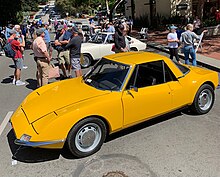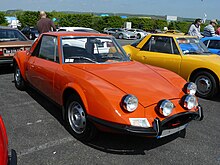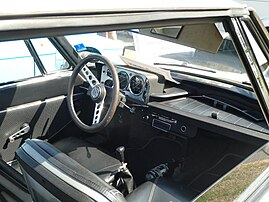| Matra M530 | |
|---|---|
 | |
| Overview | |
| Manufacturer | Matra Automobiles |
| Also called | Matra Sports M530 A Matra Sports M530 LX/SX |
| Production | 1967–1973 |
| Assembly | France |
| Designer |
|
| Body and chassis | |
| Class | Sports car |
| Body style | 2-door targa top 2+2 |
| Layout | MR layout |
| Related |
|
| Powertrain | |
| Engine | 1.7 L Taunus OHV V4 |
| Transmission | 4-speed manual |
| Dimensions | |
| Wheelbase | 2.65 m (104.3 in) |
| Length | 4.197 m (165.2 in) |
| Width | 1.62 m (63.8 in) |
| Height | 1.20 m (47.2 in) |
| Curb weight |
|
| Chronology | |
| Predecessor | Matra Djet |
| Successor | Matra Bagheera |
The Matra Sports M530 is a sports car created and built by the French engineering group Matra. It was in production from 1967 to 1973.
Development
In 1965 Matra's CEO Jean-Luc Lagardère decided to develop a successor to the Matra Djet that was more appealing to the non-racing public — a voiture des copains (car for friends). The resulting Matra M530 was the first "true" Matra sports car, the Djet having been a René Bonnet design. The car was named after Matra's R.530 missile, and was designed by former Simca designer Philippe Guédon, with the body styled by Jacques Nochet.
Features
Although both the Djet and the M530 had glass reinforced plastic (GRP) bodywork and mid-engine layouts, the Djet used a relatively simple steel backbone chassis with a large-diameter centre spine and an engine cradle and outriggers of smaller diameter square-section steel tube, while the M530 was built on a steel platform chassis with perforations for lightness. To accommodate a mid-mounted engine and yet still provide 2+2 seating and a reasonable boot, various engine options were considered. In the end, the running gear came from the Ford Mustang I prototype by way of Ford Germany. The "high compression" 1699 cc Ford Taunus V4 engine and transaxle combination from the Taunus 15M TS was compact enough to fit between the rear seats and the boot.
Other noteworthy features of the M530 were its targa top roof, hidden headlamps and avant-garde design.
M530/M530 A

The Matra Sports M530 debuted on 7 March 1967 at the Geneva Motor Show. With 70 DIN hp from its Ford V4 engine, the car had a top speed of 175 km/h (109 mph). It entered production in April, incorporating modifications that included a new chrome bumper bar to provide much-needed protection for the front grill, a modestly reshaped dashboard to give the passenger more knee room, and a repositioned ignition key to facilitate access. For its first two years of production, the chassis was built by Carrier in Alençon and final assembly was done by French coachbuilder Brissonneau et Lotz at Creil. The engine bay of early M530s was accessible by removing its acrylic glass rear window.
1969 brought many changes to the M530. Firstly, the engine benefited from changes made by Ford to their own product line, including use of a different carburetor, which raised power output to 75 CV (55 kW). Secondly, Matra closed a deal with Chrysler Europe, to sell their cars through the Simca dealer network from 1970 onwards and jointly develop the M530's successor. Thirdly, the cars were now entirely constructed at the Matra Automobiles factory in Romorantin. Lastly, the car was now badged M530 A.
British magazine "Autocar" tested a Matra M530 A in March 1969. The car had a top speed of 95 mph (153 km/h) and accelerated from 0-60 mph (97 km/h) in 15.6 seconds. An "overall" fuel consumption of 26.9 miles per imperial gallon (10.5 L/100 km; 22.4 mpg‑US) was recorded. This put it significantly behind the similarly priced Lotus Elan +2 on performance, but the two cars were closely matched on fuel economy. The Matra's £2,160 manufacturer's recommended price was a little lower than the £2,244 price on the Lotus, but both were massively undercut by the £1,217 then being asked for the MG MGB GT which, although based on an older simpler design, sold in greater numbers. Also included in the price comparison was the Porsche 912 then being offered in the UK with a manufacturer's recommended retail price of £2,894. The testers commended the Matra's refinement, handling and steering, soundness of construction and finish, while noting that its performance was 'not outstanding'.
M530 LX
Introduced at the 1970 Geneva Motor Show, the Matra Sports M530 LX was a minor redesign of the M530 A by Michelotti. Notable changes included a new glass rear hatch held open with struts, and a new front bumper.
M530 SX

A budget version of the M530, the Matra Sports M530 SX, was introduced in October 1971 with a price under 20,000 francs. The SX has a fixed roof, and instead of hidden headlamps has four fixed lamps mounted on its nose. The only available colours were yellow and white, and the SX features black bumpers instead of the LX's chrome ones.
Production numbers
Production of the M530 ceased in 1973 after a total of 9,609 cars (2,062 M530, 1,669 M530 A, 4,731 M530 LX and 1,146 M530 SX) were built.
No right-hand drive M530s were built.
Customs and Specials
Delaunay M530
French artist Sonia Delaunay, creator of the Orphism art style that emphasized colour and geometric shapes, painted a pre-production M530 at the request of Lagardère in 1968.
Vignale M530
Carrozzeria Alfredo Vignale presented a custom bodied M530 coupé designed by Virginio Vairo at the Geneva show in 1968. The car appeared again in Turin with some modifications and a new paint scheme.
Michelotti Matra Laser
Giovanni Michelotti developed a one-off M530-based "Laser" design study that featured gull-wing doors. The car was first shown in yellow at the 1971 Geneva Motor Show, and the next year appeared at the 1972 Montreal Auto Salon in silver. The car's location was unknown for several years, until it surfaced at the second Tokyo Concours d’Elegance in 2009.
Diebold M530
French designer and one-time Renault employee Camille Diebold designed a custom body for the M530 in 1973. Construction on the car began in 1974, and was completed by 1975.
M530 V6
A special M530 was prepared by British engineering firm and engine specialist Weslake for the Critérium des Cévennes. The Taunus V4 in this car was replaced by a Ford Cologne V6 engine. The car did not race.
M540
Built using the chassis of the M530 V6, this car had the Ford engine replaced by a Simca Type 180 inline four cylinder engine. Created after Chrysler-France assumed control of Matra, the changes necessary to adapt the transaxle to the Chrysler engine made this version too expensive to produce.
Gallery
-
 Matra M530 rear view
Matra M530 rear view
-
 M530 interior
M530 interior
-
M530 painted by Sonia Delaunay
-
 M530 by Vignale
M530 by Vignale
-
M530 by Camille Diebold
Technical specifications
| Model | M530 | M530A | M530 LX | M530 SX |
|---|---|---|---|---|
| Years of production | March 1967 to April 1969 | April 1969 to March 1970 | March 1970 to February 1973 | September 1971 to February 1973 |
| Units produced | 2063 | 1669 | 4731 | 1146 |
| Engine | Ford Taunus V4 Type P5S | Ford Taunus V4 Type C3 | ||
| Position and orientation | Rear-mid engine, longitudinal | |||
| Number and arrangement of cylinders | 4 cylinders in 60° "V" | |||
| Bore x Stroke | 90 mm × 66.8 mm (3.5 in × 2.6 in) | |||
| Displacement | 1,699 cc (103.7 cu in) | |||
| Carburation | One single-barrel Solex 32 PDSIT4 carburetor | One two-barrel Solex 32 TDID carburetor | ||
| Valvetrain | Single cam-in-block with pushrod actuated overhead valves. 2 valves per cylinder. | |||
| Compression ratio | 9.0:1 | |||
| Maximum horsepower | 54.4 kW (73 hp) at 4800 rpm | 58.2 kW (78 hp) at 5000 rpm | ||
| Maximum torque | 132 N⋅m (97.4 lb⋅ft) at 2800 rpm | |||
| Clutch | Dry single-plate | |||
| Driven wheels | Rear | |||
| Transmission | 4-speed manual | |||
| Chassis | Platform chassis in sheet steel with perforations for lightness. Fibreglass bodywork attached to chassis. | |||
| Front suspension | Upper and lower wishbones, coil springs, telescopic dampers, anti-roll bar | |||
| Rear suspension | Trailing arms, coil springs, telescopic dampers, anti-roll bar | |||
| Braking | Dual hydraulic circuit. Disk brakes on all four wheels | |||
| Weight | 860 kg (1,896.0 lb) | |||
| Fuel capacity | 45 L (11.9 US gal) | |||
| Maximum speed | 170 km/h (105.6 mph) | |||
| Average fuel consumption | 11.1 l/100 km (25 mpg‑imp; 21 mpg‑US) | |||
References
- Bonnafous, Gilles (2003-03-24). "Saga Matra — Interview de Philippe Guédon" [Matra Saga — Interview with Philippe Guédon]. www.motorlegend.com (in French).
- ^ Krol, Régis (2022-03-16). "La Matra 530 et ses dérivés" [The Matra 530 and its derivatives]. blogautomobile.fr (in French).
- Norbye, Jan. P. (March 1969). "New French Sports Car Has Mid Engine". Popular Science. pp. 110–111.
- Herzog, Frank (2011-03-24). "Matra M 530 LX: The bizarre French in the driving report". topgear-autoguide.com. Retrieved 2022-01-25.
- "Toutes les voitures françaises 1968 (salon 1967)". Automobilia. Vol. 29. Paris: Histoire & collections. 2004. pp. 42–43.
- "MATRA 530 (1967 – 1973)". www.automobile-sportive.com (in French). 2009-06-25.
- "Autotest — Matra M530A". Autocar. Vol. 130 (nbr 3813). 13 March 1969. pp. 6–11.
- ^ "Matra 530 History & Specs". www.matra-club.net. 22 December 2016.
- Sorth, Lennart. "The Matra M530". www.matrasport.dk.
- Verges, Patrice (13 October 2006). "L'Incroyable Collection — Matra 530 Sonia Delaunay". Archived from the original on 2016-03-04. Retrieved 2024-06-14.
- "Vignale Matra M530 Sport 1968". www.coachbuild.com. 2017-07-28.
- Breeze, Joe (12 December 2011). "Classic Concepts: 1971 Matra Laser by Michelotti". www.classicdriver.com.
- ^ "Matra 530 Speciales". www.matra-passion.com (in French).
External links
| Matra-DB-René Bonnet car timeline, 1955–1984 | |||||||||||||||||||||||||||||||||||||||||||||||||||||||||||||||||||||||||||||||||||||||||||||||||||||||||||||||||||||||||||||||||||||||||||||||||||||||||||||||||||||||||||||||||||||||||||||||||||||||||||||||||||||||||||||||||||||||||||||||||||||||||||||||||||||||||||
|---|---|---|---|---|---|---|---|---|---|---|---|---|---|---|---|---|---|---|---|---|---|---|---|---|---|---|---|---|---|---|---|---|---|---|---|---|---|---|---|---|---|---|---|---|---|---|---|---|---|---|---|---|---|---|---|---|---|---|---|---|---|---|---|---|---|---|---|---|---|---|---|---|---|---|---|---|---|---|---|---|---|---|---|---|---|---|---|---|---|---|---|---|---|---|---|---|---|---|---|---|---|---|---|---|---|---|---|---|---|---|---|---|---|---|---|---|---|---|---|---|---|---|---|---|---|---|---|---|---|---|---|---|---|---|---|---|---|---|---|---|---|---|---|---|---|---|---|---|---|---|---|---|---|---|---|---|---|---|---|---|---|---|---|---|---|---|---|---|---|---|---|---|---|---|---|---|---|---|---|---|---|---|---|---|---|---|---|---|---|---|---|---|---|---|---|---|---|---|---|---|---|---|---|---|---|---|---|---|---|---|---|---|---|---|---|---|---|---|---|---|---|---|---|---|---|---|---|---|---|---|---|---|---|---|---|---|---|---|---|---|---|---|---|---|---|---|---|---|---|---|---|---|---|---|---|---|---|---|---|---|---|---|---|---|---|---|---|
| |||||||||||||||||||||||||||||||||||||||||||||||||||||||||||||||||||||||||||||||||||||||||||||||||||||||||||||||||||||||||||||||||||||||||||||||||||||||||||||||||||||||||||||||||||||||||||||||||||||||||||||||||||||||||||||||||||||||||||||||||||||||||||||||||||||||||||